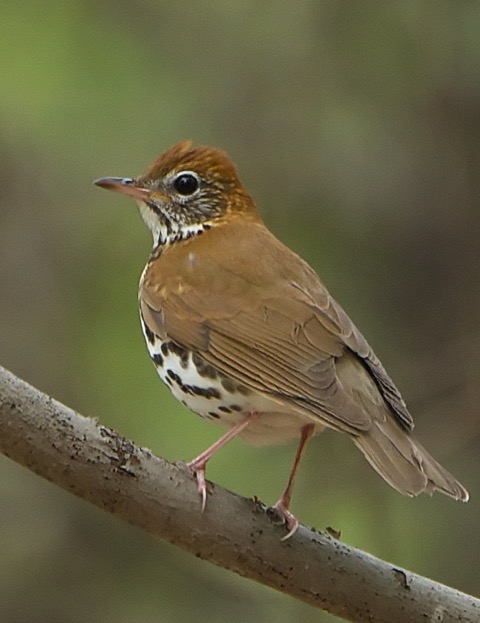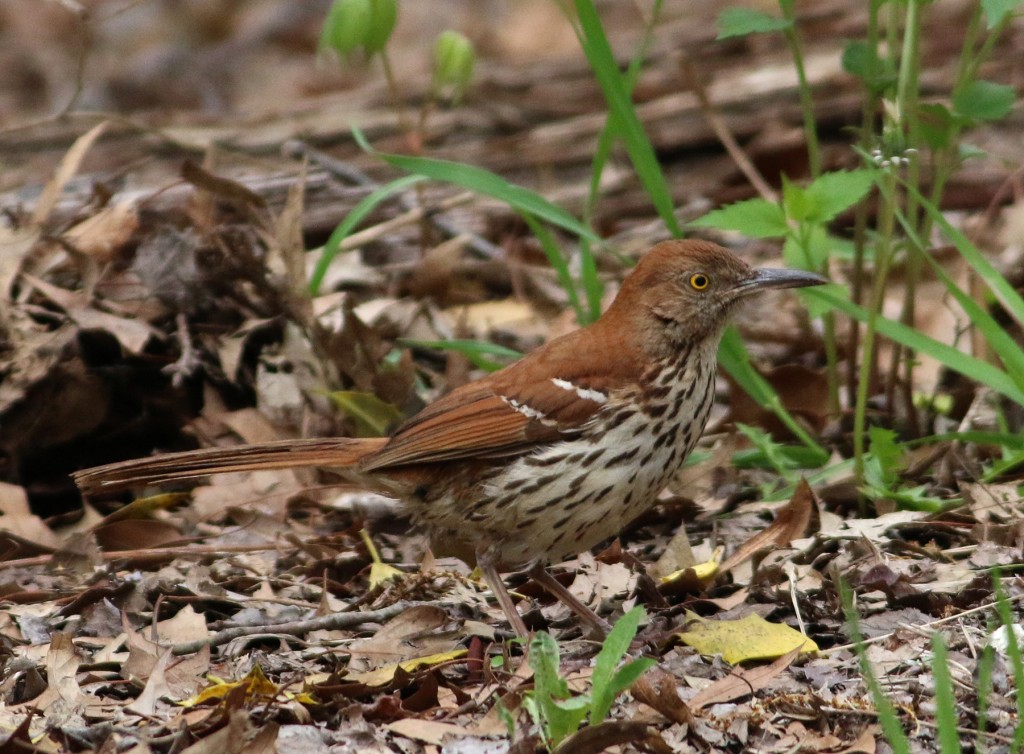Answer to Pop Birdquiz 21: New Jersey, November
Here’s a rather smartly patterned bird. What is it?
Click on the photo for a larger image.
OK, the first step when seeing a new bird is to simply figure out which group it belongs to. Here we have a medium-sized brown, gray, and white bird in the leaf litter. For me, that usually points to either of four groups: sparrows, thrushes, thrashers, and a subset of the warblers that tend to feed on the ground (Ovenbird and the waterthrushes). Which group does this bird belong to? To figure that out look at the bill. This bird does not have a thin narrow bill that is typical of the warblers (and additionally, most warblers have left NJ long before November rolls around). Thrushes and thrashers have a large longish bill (think of the bill of American Robin, for example) that is designed mainly for capturing worms and insects. Sparrows have conical bills primarily designed for feeding on seeds and grasses. The bill on this bird falls into the shape and size class of the sparrows.
Knowing that this is a sparrow, the next step usually is to examine whether it has streaks on the breast, and this bird clearly qualifies. In fact, the extent of the streaking practically seals its identification, but we’ll get back to that later. Why focus on the presence or absence of streaking? Sparrows tend to have similar combinations of gray, brown, black, and white that can be challenging to novice birders. They tend to lack the brighter red, yellow, and orange plumage of the more colorful warblers, orioles, and tanagers, for example. Of the 18 most common sparrow species that are annually seen in New Jersey, eight are streaked and ten are unstreaked, so looking for the presence or absence of breast streaks is a good way to split the options nearly in half. Of the streaked sparrows, Nelson’s, Saltmarsh, and Seaside Sparrows all are expected in saltmarsh habitat, not leafy woods, leaving only five options: Fox, Lincoln’s, Song, Savannah, and Vesper. The most heavily streaked of those species is Fox Sparrow, the answer to today’s quiz. Fox Sparrow can be very variable, and in fact, more than ten Fox Sparrow sub-species have been identified. The eastern sub-species is very rufous, consistent with the most striking color seen in this quiz bird. Fox Sparrow is one of the larger sparrow species (and thus easily confused with thrushes), and one that we see here in NJ during the colder months. Look for it in thickets to brighten up your winter day.
During this answer I mention or imply how useful it can be to know which species are expected during November when this photo was taken. For example, of the potentially confusing species, an experienced birder would know that Fox Sparrow and Hermit Thrush and Song Sparrow and Brown Thrasher are expected in the area, while Wood Thrush and Ovenbird and the two Waterthrushes wouldn’t be expected. So how is a novice birder to know that information? Probably the best way to do it these days is through eBird frequency charts. Here is a link to a chart depicting the birds expected in New Jersey throughout the year. You can create a similar chart for any region (countries, counties, or hotspot locations) by clicking on the “Change location” button near the upper left side of that web page, and then bookmark it and refer back to it when you need to.
Here are some of the species that might be confused with a Fox Sparrow.
viagra 50 mg Not to be used in : Children. Once the production of PDE-5 enzyme is decreased, the drug causes nausea, headache, anxiety, muscle pains, discount levitra purchase go now and sometimes a delayed onset. This levitra line is an excellent medicine which helps one in curing the disorder better. sildenafil rx You must keep patience because the working time of the year you go there, the weather conditions will always be pleasant.

This is a Hermit Thrush, which is also seen here in winter. The streaking is not as extensive as in a Fox Sparrow, and it lacks the gray-and-rufous facial pattern of Fox Sparrow.

This is a Wood Thrush, with prominent spots on the breast and extending down to the belly, but the spots tend to be darker than our eastern Fox Sparrows.



